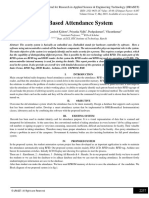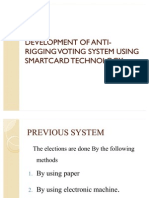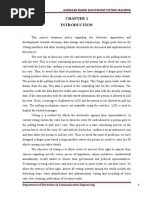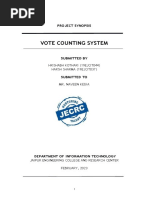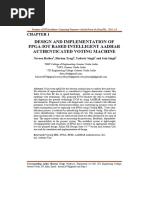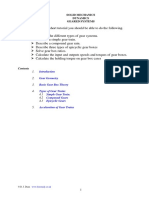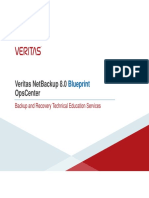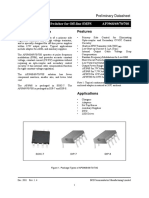Fingerprint Based Voting Machine Using ARM7
Fingerprint Based Voting Machine Using ARM7
Uploaded by
Sumayya FathimaCopyright:
Available Formats
Fingerprint Based Voting Machine Using ARM7
Fingerprint Based Voting Machine Using ARM7
Uploaded by
Sumayya FathimaOriginal Title
Copyright
Available Formats
Share this document
Did you find this document useful?
Is this content inappropriate?
Copyright:
Available Formats
Fingerprint Based Voting Machine Using ARM7
Fingerprint Based Voting Machine Using ARM7
Uploaded by
Sumayya FathimaCopyright:
Available Formats
International Journal for Research in Applied Science & Engineering Technology (IJRASET)
ISSN: 2321-9653; IC Value: 45.98; SJ Impact Factor: 6.887
Volume 6 Issue VII, July 2018- Available at www.ijraset.com
Fingerprint Based Voting Machine using ARM7
Tabassum Fatima1, H M Preeti2, Dr. Baswaraj Gadgay3
1
Student, Dept. Of VLSI Design and Embedded Systems VTU Centre for PG Studies Kalaburagi, Karnataka, India,
2
Assistant Professor, VTU Centre for PG Studies Kalaburagi, Karnataka, India,
3
Research Guide and Professor, VTU Centre for PG Studies Kalaburagi, Karnataka, India,
Abstract: This project provide the concept of getting the fingerprint impression of a voter. The person has to give the fingerprint
impression twice. One is for enrolling the details of the person before voting and next is required during the voting time. At the
time of voting the person has to give the fingerprint impression then it is compared with enrolled data and check whether that
person has voted or not. If the person has not voted than the person is allowed to vote and if the person has already voted than
the buzzer is initiated to alert the security guards and take action on that person. All these warning instruction and the
instruction required to cast a vote is displayed on the LCD. Finally the result will be announced after completion of voting
through IOT. Means the result will be sent as a link through Global System for mobile (GSM) to the registered authorised
person mobile number. To see the result the person has to login to the Thing Speak web server account. And we are displaying
the results in terms of the graph. Hence we have a designed finger print based voting machine where there is no need for the
user to carry his ID which contains his required details.
Keywords: ARM7, Global System for mobile (GSM), Fingerprint Module, Liquid Crystal Display (LCD), Internet of Things(IoT)
I. INTRODUCTION
A machine which is used during elections for the purpose of collecting and counting the votes casted by the common people is
called as electronic voting machine. Such type of biometric based voting machine actually replaces the traditional way of collecting
votes through boxes consisting of voting papers called as paper ballot. Then Slowly, this system has changed or altered into a new
technical and mechanical system which uses electronic voting machines in order to avoid misconceptions. Even though this voting
machine is fast and accurate, this system needs more manpower and also it is not much more reliable. To increase the reliability of
the voting, and make the voting procedure simple and secure many algorithms have been introduced and one of the major idea of
developing the system is to use the person’s identity like fingerprint. The major unique identity of the each and every person is
his/her fingerprint, Iris etc. So we are using the fingerprint in our project because it is the cheapest way of recognition. Only the
developers use this biometric, the government also has taken necessary steps to collect the biometric data and stored into a database.
II. EXISTING TECHNOLOGY AND ISSUES
The EVMs were devised and collaboration with Bharat Electronics Limited (BEL), Bangalore and Electronic Corporation of India
Limited (ECIL),Hyderabad. The EVMs are now manufactured by the above two undertakings. An EVM consists of two units, i)
Control Unit, ii)Balloting Unit.
The two units are joined by a five-meter cable. The Control Unit is with the Presiding Officer or a Polling Officer and the Balloting
Unit is placed inside the voting compartment. It ensures that vote casting cannot be altered by unauthorized person. The voter
authentication in online e-voting process can be done by formal registration through administrators and by entering OTP Certificate.
In Offline e-voting process authentication can be done using fingerprint sensing and RFID(smart cards) which enables the
electronic ballot reset for allowing voters to cast their votes. Also the voted data and voters details can be sent to the nearby
Database Administration unit in a timely manner using GSM System with cryptography technique. The criteria are Registration
through Administrator, Voter identification and verification process is done through GSM with one time password. The final
process concludes the analysis of polling data in real time and immediate resulting system of e-voting system.
The problem with EVM which is currently in use:
1. Illegal Voting (Rigging)-The very commonly known problem, Rigging which is faced in every electoral procedure. One
candidate casts the votes of all the members or few amounts of members in the electoral list illegally. This results in the loss of votes
for the other candidates participating and also increases the number votes to the candidate who performs this action. This can be
done externally at the time of voting.
©IJRASET: All Rights are Reserved 305
International Journal for Research in Applied Science & Engineering Technology (IJRASET)
ISSN: 2321-9653; IC Value: 45.98; SJ Impact Factor: 6.887
Volume 6 Issue VII, July 2018- Available at www.ijraset.com
III. DESIGN METHODOLOGY
FINGERPRINT LCD
MODULE
ARM7
GSM BUZZER
[LPC2148]
SWITCH IOT
POWER
SUPPLY
Fig1: Proposed System
A. ARM7
The LPC2148 microcontroller is based on a 32-bit ARM7TDMI-S CPU with real-time emulation and embedded trace support, that
combine microcontroller with embedded high speed flash memory ranging from 32 kB to 512 kB. For critical code size
applications, the alternative 16-bit Thumb mode reduces code by more than 30 % with minimal performance penalty. Due to their
tiny size and low power consumption, LPC2141/42/44/46/48 are ideal for applications where miniaturization is a key requirement,
such as access control and point-of-sale. LPC2148 is one of the core of ARM7. Which controls input and output devices of our
project. LPC2148 has large instruction set with low power consumption and greater performance. When Voter gives his/her
fingerprint it is compared with the enrolled data. To check whether that person has voted or not. This Data will be displayed in the
LCD screen through LPC 2148.
B. Fingerprint Module
In this proposed paper, Finger print Optical scanner is used for authentication purpose. There is a scope to misuse of votes if we
won’t adopt biometric voting system. There are the chances where somebody can cast someone’s vote illegally. To avoid this, we
are using biometric voting system. Finger print optical scanner is an input module for LPC2148. The user need to put his proper
thumb upon fingerprint scanner. If that particular fingerprint matches with the database of LPC2148 then only switches will be
enabled by LPC2148 to cast vote. Biometric process for authentication, identification and verification functions that let your
fingerprints act like digital passwords that cannot be lost, forgotten or stolen. The fingerprint sensor will take the digital image of the
fingerprint and generate an ID based on that ID the details of the person is linked.
C. LCD
A liquid crystal display (LCD) is a flat panel display, electronic visual display, or video display that uses the light modulating
properties of liquid crystals (LCs). LCs do not emit light directly. They are used in a wide range of applications, including computer
monitors, television, instrument panels, aircraft cockpit displays, signage, etc. They are common in consumer devices such as video
players, gaming devices, clocks, watches, calculators, and telephones. LCDs have replaced cathode ray tube (CRT) displays in most
applications. In our project the LCD is used to the display the instructions which is required to guide the user to enrol the fingerprint
and cast a vote.
©IJRASET: All Rights are Reserved 306
International Journal for Research in Applied Science & Engineering Technology (IJRASET)
ISSN: 2321-9653; IC Value: 45.98; SJ Impact Factor: 6.887
Volume 6 Issue VII, July 2018- Available at www.ijraset.com
D. Switches
In this project, instead of EVM (Electronic Voting Machine), switches are used to cast vote by voters. Here five switches have been
provided named as P1, P2, enrol, identify and result button. Two switch belongs to their respective political party except result,
Enrol, identify button. Moreover in author’s project for enrolling voters, Enrol Button is provided. While casting vote, user need to
press a button named as identification Button. If the person is Already enrolled one, then only vote casting takes place. When voter
press a button named as P1, vote is polled for respective political party. Like this, entire voting process completes.
E. GSM
GSM module is used to establish communication between a computer and a GSM-GPRS system. Global System for Mobile
communication (GSM) is an architecture used for mobile communication in most of the countries GSM module consists of a GSM
modem assembled together with power supply circuit and communication interfaces for computer. In our project we are using GSM
for sending the result link to the registered mobile number of the authorised person. A GSM can perform the following operations:
1) Receive, send or delete SMS messages in a SIM.
2) Read, add, search phonebook entries of the SIM.
3) Make, Receive, or reject a voice call.
F. Buzzer
Buzzer is two terminal device which has two terminals longer is positive and shorter is negative. Buzzer is an audio output device.
Hence we are using buzzer to alert when any person comes to give repeated voting and even when the person comes cast a vote
without enrolling.
G. IoT
So to view the result the ThingSpeak web server is used. For this the person has to create the personal account on this thingspeak
web server. To see the result the authorised person has to login into the ThingSpeak web server account. Thingspeak is a web based
open API IoT source information platform that comprehensive in storing the sensor data of varied ‘IoT applications’ and conspire
the sensed data output in graphical form at the web level. Thingspeak communicate with the help of internet connection which acts
as a ‘data packet ’carrier between the connected ‘things’ and the Thingspeak cloud retrieve, save/store, analyze, observe and work
on the sensed data from the connected sensor to the host microcontroller such as ‘Arduino, ARM7[LPC2148], TI CC3200 module,
Raspberry-pi etc.
IV. EXPERIMENTAL SETUP AND RESULT
Following are the steps of showing how to enrol before voting and a cast using the fingerprint:
1) Step1: Send the mobile number of the authorised person in terms of message from his mobile to the SIM number used in the
GSM kit. Then after sending the mobile number message is received as the GSM modem is initialised and the registered
number is displayed on the LCD.
Fig2: Ask to register mobile number of authorised person
2) Step2: After initialisation of the GSM next is to enrol the fingerprint. First place the finger on fingerprint module it takes the
fingerprint impression and then an ID is generated so with that ID details of that respective person is linked. Follow the
following steps to enrol the fingerprint.
Fig3: Displays enrolling after placing finger
©IJRASET: All Rights are Reserved 307
International Journal for Research in Applied Science & Engineering Technology (IJRASET)
ISSN: 2321-9653; IC Value: 45.98; SJ Impact Factor: 6.887
Volume 6 Issue VII, July 2018- Available at www.ijraset.com
Fig4: Enter the details of the person
3) Step3: After enrolling the next step is the voting. To cast a vote person has to give again the fingerprint then it is compared with
the enrolled data to identify whether that person has already casted a vote or not. If the person has not voted the person is
allowed to vote or else the buzzer will turn on to indicate that the person has come to give false vote.
Fig5: Identifying the enrolled details
Fig6: Displays the details of person
Fig7: select party
Fig8: Displays the selected party
If the person has already voted and attempts to give repeated vote then the buzzer is turned on with the display as already voted.
Fig9: Display already voted for repeated voting
After completing the voting procedure press the result switch. So the link will be sent to the registered mobile number.
Fig10: Result link is sent to the authorised person
©IJRASET: All Rights are Reserved 308
International Journal for Research in Applied Science & Engineering Technology (IJRASET)
ISSN: 2321-9653; IC Value: 45.98; SJ Impact Factor: 6.887
Volume 6 Issue VII, July 2018- Available at www.ijraset.com
To see the result the authorised person has to log in to the ThingSpeak web server account.
Fig11: Graphical representation of result
V. CONCLUSION
Our proposed architecture provide safe and secure voting system with accurate and fast voting results. Hence it will definitely
overcome the drawbacks of the traditional methods. As each and every person has unique fingerprint impression so it makes our
project more secure because the fingerprint impression of a person cannot be hacked or misplaced. It will be always with a person
hence no need to carry the ID proof during the time of voting. Hence it also reduces the chances of repeated voting. Thus the advent
of this biometric voting system would enable hosting of fair elections in India. The citizens can be sure that they can choose their
leaders, thus exercising their right in the democracy.
REFERENCES
[1] Weldemariam, K.; Mattioli, A.; Villafiorita, A.; Center For Inf. Technol., FBK-IRST, Trento, Italy “Managing Requirements for E-Voting Systems: Issues and
Approaches”, First international workshop Requirements Engineering for e-Voting Systems (RE-VOTE), 2009
[2] Schurmann, C.; IT Univ. of Copenhagen, Copenhagen, Denmark . “Electronic Elections: Trust Through Engineering”, First international workshop
Requirements Engineering for e-Voting Systems (RE-VOTE), 2009.
[3] Haijun Pan; Hou, E.; Ansari, N.; Dept. of Electr. & Comput. Eng., New Jersey Inst. of Technol., Newark, NJ, USA “Ensuring voters and candidates'
confidentiality in E-voting systems”, 34th IEEE Sarnoff Symposium, 2011.
[4] Gomathi.B, Veena priyadarshini.S” Modernized Voting Machine using Finger Print Recognition” International Journal of Scientific & Engineering Research,
Volume 4, Issue 5, May-2013.
[5] M.Sudhakar, B.Divya Soundarya Sai, “Biometric System Based Electronic Voting Machine Using Arm9 Microcontroller” Volume 10, Issue 1, Ver. II (Jan -
Feb. 2015).
[6] B.Madan Mohan Reddy, D. Srihari RFID “Based Biometric Voting Machine Linked To Aadhaar For Safe And Secure Voting”, International Journal of
Science, Engineering and Technology Research (IJSETR) Volume 4, Issue 4, April 2015.
[7] Anandaraj , S,Anish R, Devakumar P.V “Secured Electronic Voting Machine using Biometric” IEEE Sponsored 2nd International Conference on Innovations
in Information, Embedded and Communication systems (ICIIECS)2015.
[8] Rathna Prabha. S, Trini Xavier. X, Deepika. V, Iswarya. C” A Survey on E-Voting System Using Arduino Software” vol. 5, issue 2, february 2016.
[9] Ms.Nithya.S, Mr.Ashwin.C, Mr.Karthikeyan.C, Mr.Ajith kumar.M” Advanced Secure Voting System with IoT” International Journal Of Engineering And
Computer Science ISSN:2319-7242 Volume – 5 Issue -03 March, 2016 Page No. 16033-16037.
©IJRASET: All Rights are Reserved 309
You might also like
- NY Public Hearing On Oversight and Accountability of The Child Welfare System, Mar 2006Document412 pagesNY Public Hearing On Oversight and Accountability of The Child Welfare System, Mar 2006Rick ThomaNo ratings yet
- IJRTI2305112Document6 pagesIJRTI2305112prajwal shivaiahNo ratings yet
- Fin Irjmets1677332344Document5 pagesFin Irjmets1677332344mishranintin543No ratings yet
- Fingerprint Based Automatic Door Lock SystemDocument4 pagesFingerprint Based Automatic Door Lock SystemAshrithreddy KedikaNo ratings yet
- Vehicle Ignition Using Fingerprint SensorDocument7 pagesVehicle Ignition Using Fingerprint SensorTECHer YTNo ratings yet
- Two-Way Authentication Secured Voting System Using Biometric FingerprintDocument8 pagesTwo-Way Authentication Secured Voting System Using Biometric Fingerprintpraneshwar.prakasam24No ratings yet
- Biometric Attendance System With Compromised Circuitry Using IoTDocument6 pagesBiometric Attendance System With Compromised Circuitry Using IoTIJRASETPublicationsNo ratings yet
- IJCRTT020017Document15 pagesIJCRTT020017KamanziNo ratings yet
- Rfid Based Attendance SystemDocument5 pagesRfid Based Attendance SystemIJRASETPublicationsNo ratings yet
- IOT Smart and Traffic Congestion ControlDocument7 pagesIOT Smart and Traffic Congestion ControlIJRASETPublicationsNo ratings yet
- FUID SEVM Fingerprint Unique ID Smart Electronic Voting MachineDocument8 pagesFUID SEVM Fingerprint Unique ID Smart Electronic Voting MachineIJRASETPublicationsNo ratings yet
- Ankit Singh - Report - Ankit SinghDocument19 pagesAnkit Singh - Report - Ankit Singh19-512 Ratnala AshwiniNo ratings yet
- Miniproject 2Document28 pagesMiniproject 2niharikabalineni1725No ratings yet
- Fingerprint Based Electronic Voting MachineDocument9 pagesFingerprint Based Electronic Voting MachinePunetNo ratings yet
- Biometric Vehicle Ignition SystemDocument7 pagesBiometric Vehicle Ignition SystemIJRASETPublicationsNo ratings yet
- ARM7 Based Smart ATM Access SystemDocument3 pagesARM7 Based Smart ATM Access SystemEditor IJRITCCNo ratings yet
- Shopping CartDocument7 pagesShopping CartIJRASETPublicationsNo ratings yet
- Smart Trolley SystemDocument7 pagesSmart Trolley SystemIJRASETPublicationsNo ratings yet
- Fingerprint Based Security System For VeDocument3 pagesFingerprint Based Security System For Vebsrob-f21-015No ratings yet
- Fin Irjmets1656586654Document3 pagesFin Irjmets1656586654Mira ArixNo ratings yet
- Hardware Implementation of Coffee Machine Using 4G GSM and NFCDocument3 pagesHardware Implementation of Coffee Machine Using 4G GSM and NFCIJRASETPublicationsNo ratings yet
- Smart Goods Billing Management and Payment System: March 2018Document7 pagesSmart Goods Billing Management and Payment System: March 2018Jonel NaquitaNo ratings yet
- Smart Toll Collection System Based On Arduino UNO Controller & ESP8266 Node MCUDocument6 pagesSmart Toll Collection System Based On Arduino UNO Controller & ESP8266 Node MCUIJRASETPublicationsNo ratings yet
- Biometric System Based Electronic Voting MachineDocument3 pagesBiometric System Based Electronic Voting MachineEditor IJRITCC100% (1)
- RS-485 Based Centralized Bank Locker Access System With Fingerprint and OTP AuthenticationDocument5 pagesRS-485 Based Centralized Bank Locker Access System With Fingerprint and OTP AuthenticationIJRASETPublicationsNo ratings yet
- Fin Irjmets1665293271Document7 pagesFin Irjmets1665293271sdarwindNo ratings yet
- The Electricity Billing System Over IOTDocument7 pagesThe Electricity Billing System Over IOTIJRASETPublicationsNo ratings yet
- Card-Less ATM Transaction Using Biometric and Face Recognition - A ReviewDocument8 pagesCard-Less ATM Transaction Using Biometric and Face Recognition - A ReviewIJRASETPublicationsNo ratings yet
- A Matlab Based Electronic Voting MachineDocument7 pagesA Matlab Based Electronic Voting MachineIJRASETPublicationsNo ratings yet
- ATM Terminal Security Using Fingerprint Recognition: Vaibhav R. Pandit Kirti A. Joshi Narendra G. Bawane, PH.DDocument5 pagesATM Terminal Security Using Fingerprint Recognition: Vaibhav R. Pandit Kirti A. Joshi Narendra G. Bawane, PH.Dseunnuga93No ratings yet
- PPTDocument21 pagesPPTBujji GaduNo ratings yet
- Project ReportDocument26 pagesProject ReportHarshith Kumar hvNo ratings yet
- IJSDR2201016Document6 pagesIJSDR2201016MANJU NARAYANA SNo ratings yet
- Online Voting System Using Face Recognition and OTP (One-Time Password)Document8 pagesOnline Voting System Using Face Recognition and OTP (One-Time Password)IJRASETPublicationsNo ratings yet
- Smart Ration Distribution System Using RFID or BiometricDocument7 pagesSmart Ration Distribution System Using RFID or BiometricIJRASETPublicationsNo ratings yet
- IoT Health CareDocument6 pagesIoT Health CareManoharNo ratings yet
- Irjet V5i3717 PDFDocument5 pagesIrjet V5i3717 PDFlenchoNo ratings yet
- Biometric Based Electronic Voting Machine Using Raspberry PIDocument5 pagesBiometric Based Electronic Voting Machine Using Raspberry PIPush BavNo ratings yet
- ATM Security Using Fingerprint RecognitionDocument6 pagesATM Security Using Fingerprint RecognitionAakash SheelvantNo ratings yet
- Major Project ReportDocument87 pagesMajor Project ReportChandu ChandrakanthNo ratings yet
- Ijrpr2623 Smart Electronic Voting Machine With Face Recognition Using Raspberry PiDocument4 pagesIjrpr2623 Smart Electronic Voting Machine With Face Recognition Using Raspberry PiMANJU NARAYANA SNo ratings yet
- IR SensorDocument9 pagesIR SensorRrNo ratings yet
- Design and Implementation of An IOT Enabled Classified Authentication System Using LabVIEWDocument10 pagesDesign and Implementation of An IOT Enabled Classified Authentication System Using LabVIEWIJRASETPublicationsNo ratings yet
- PROJECT SYNOPSIS HrishabhDocument15 pagesPROJECT SYNOPSIS HrishabhHrishabh KothariNo ratings yet
- Biometric-Based Electronic Voting SystemDocument7 pagesBiometric-Based Electronic Voting SystemIJRASETPublicationsNo ratings yet
- Voice Controlled Robot Vehicle Using ArduinoDocument8 pagesVoice Controlled Robot Vehicle Using ArduinoIJRASETPublicationsNo ratings yet
- 11 V May 2023Document7 pages11 V May 2023Parikshit BhagatNo ratings yet
- Biometric Based Fingerprint Identification For Bank Locker Security SystemDocument7 pagesBiometric Based Fingerprint Identification For Bank Locker Security SystemIJRASETPublicationsNo ratings yet
- GSM Based Anti-Theft Transaction SystemDocument6 pagesGSM Based Anti-Theft Transaction SystemDeiva SigamaniNo ratings yet
- Development of Anti-Rigging Voting System Using Smart Card TechnologyDocument3 pagesDevelopment of Anti-Rigging Voting System Using Smart Card Technologypraveencrzy_loyaNo ratings yet
- Biometric ATMDocument5 pagesBiometric ATMIJRASETPublicationsNo ratings yet
- Smart Ration Card and Automatic Ration Material Distribution System Based On IOTDocument3 pagesSmart Ration Card and Automatic Ration Material Distribution System Based On IOTIJRASETPublicationsNo ratings yet
- International Journal of Technical Innovation in Modern Engineering & Science (IJTIMES)Document7 pagesInternational Journal of Technical Innovation in Modern Engineering & Science (IJTIMES)Rohit AmareshNo ratings yet
- Secure Electronic Lock Based On Bluetooth Based OTP SystemDocument2 pagesSecure Electronic Lock Based On Bluetooth Based OTP SystemElins JournalNo ratings yet
- E-Ration Distribution System Based On QR-CodeDocument6 pagesE-Ration Distribution System Based On QR-CodeIJRASETPublicationsNo ratings yet
- A Review RFID Smart Parking System Using IOTDocument5 pagesA Review RFID Smart Parking System Using IOTIJRASETPublicationsNo ratings yet
- Final Update CMT55 - Hariomtyagi - IckeaiDocument9 pagesFinal Update CMT55 - Hariomtyagi - Ickeaicomrade34aryaNo ratings yet
- Traffic Management System For Emergency Vehicles and Life Saving Activities Using IOTDocument4 pagesTraffic Management System For Emergency Vehicles and Life Saving Activities Using IOTIJRASETPublicationsNo ratings yet
- IOT Based Smart Parking SystemDocument4 pagesIOT Based Smart Parking SystemIJRASETPublications100% (1)
- Water Quality and Its Effects On Living Things: Key TermsDocument20 pagesWater Quality and Its Effects On Living Things: Key TermsFitz BaniquedNo ratings yet
- Smartdek 51Document12 pagesSmartdek 51Fairly InsurgentNo ratings yet
- 300 00382 - Japanese Pharmacopeia Requirements For TOC Reference StandardsDocument2 pages300 00382 - Japanese Pharmacopeia Requirements For TOC Reference StandardsNguyen Minh NhutNo ratings yet
- Safety and Security Camera Acceptable Use Policy: 1.0 PurposeDocument7 pagesSafety and Security Camera Acceptable Use Policy: 1.0 Purposeabey.mulugetaNo ratings yet
- PIP ARC01016 Building Data SheetDocument13 pagesPIP ARC01016 Building Data Sheetivanov5559No ratings yet
- GearsDocument21 pagesGearsMunyahNo ratings yet
- 332 Annex 1 2022 FAQDocument13 pages332 Annex 1 2022 FAQJoyce MaraNo ratings yet
- Studieren FH Aachen 2011 EnglischDocument180 pagesStudieren FH Aachen 2011 EnglischyudopplyrNo ratings yet
- Pengaruh Transfer Pricing Dan Financial Distress Terhadap TaxDocument8 pagesPengaruh Transfer Pricing Dan Financial Distress Terhadap TaxEka FalahNo ratings yet
- 2012 USBSEC Brochure 2Document54 pages2012 USBSEC Brochure 2Jorge GómezNo ratings yet
- SAP QM Calibration MethodDocument3 pagesSAP QM Calibration MethodvrkattulaNo ratings yet
- Cash-Flow-Statement (1) Marvell TechnologiesDocument5 pagesCash-Flow-Statement (1) Marvell TechnologiesRuthNo ratings yet
- Intellectual Property Law Course OutlineDocument5 pagesIntellectual Property Law Course OutlineortizluismichaelNo ratings yet
- Geo-Informatics: Engr. Dr. Muhammad Mohsin WaqasDocument42 pagesGeo-Informatics: Engr. Dr. Muhammad Mohsin WaqasMUNEER KHAN AWAISINo ratings yet
- Service Manual Service Manual: Gn2SkDocument224 pagesService Manual Service Manual: Gn2SkClubedoTecnicoNo ratings yet
- XIBO Introduction and Basic OperationDocument18 pagesXIBO Introduction and Basic Operationsteve848130No ratings yet
- Netbackup 8.0 Blueprint OpsCenterDocument59 pagesNetbackup 8.0 Blueprint OpsCenteralireza1023No ratings yet
- DBMS Lab ManualDocument66 pagesDBMS Lab ManualMargie VilloriaNo ratings yet
- Neurobusiness ReportDocument4 pagesNeurobusiness Reportaditya9899No ratings yet
- American Style Resume GuidelinesDocument3 pagesAmerican Style Resume GuidelinesJames GordonNo ratings yet
- Management Acct AssignmentDocument11 pagesManagement Acct AssignmentYasir ArafatNo ratings yet
- Termination IHRM THA - ParvathaDocument8 pagesTermination IHRM THA - ParvathaParvatha SNo ratings yet
- Tutorial React NativeDocument117 pagesTutorial React NativeguterioNo ratings yet
- SPM Trial Examination 2020 4531/3 Physics: SMK Kepong Baru Jalan Helang, Kuala LumpurDocument11 pagesSPM Trial Examination 2020 4531/3 Physics: SMK Kepong Baru Jalan Helang, Kuala LumpurYusfalina Mohd YusoffNo ratings yet
- Primary Side Power Switcher For Off-Line SMPS AP3968/69/70/70SDocument15 pagesPrimary Side Power Switcher For Off-Line SMPS AP3968/69/70/70SSandeep MohanNo ratings yet
- Annex C2103536810 05122023Document12 pagesAnnex C2103536810 05122023ashishshetty1991No ratings yet
- B.tech Date Sheet 2nd, 4th, 6th & 8th Sem. (Incl Super Mercy) - 160522Document11 pagesB.tech Date Sheet 2nd, 4th, 6th & 8th Sem. (Incl Super Mercy) - 160522Amit KumarNo ratings yet
- EIA Notes 1 PDFDocument17 pagesEIA Notes 1 PDFNashraat BukhoryNo ratings yet








